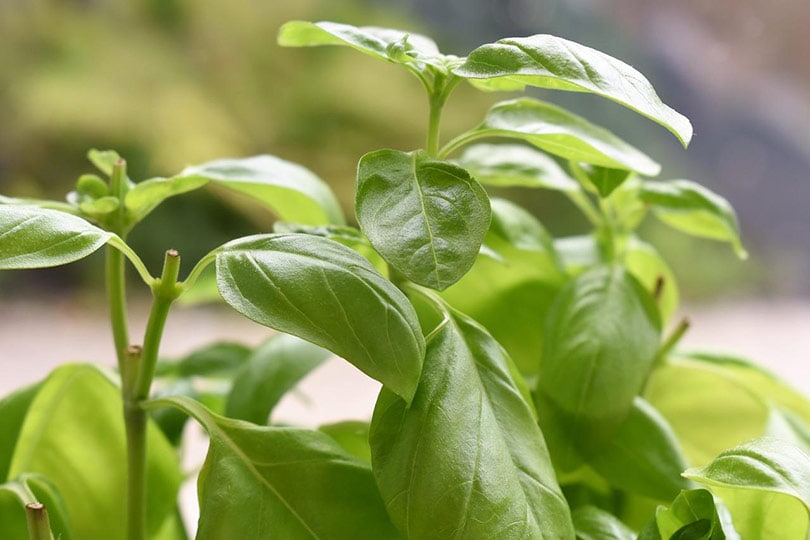How Much & How Often to Water Basil: Factors & Maintenance
-
Chris Dinesen Rogers
- Last updated:

Few herbs are as popular and globally recognized as basil (Ocimum basilicum). It’s an attractive plant that makes its presence known by its distinctive scent, thanks to its evolutionary history as part of the mint family. While native to India and Southern Asia, the etymology of the word suggests it predates the ancient Greeks. “Basil” means “royal” in Greek, which reveals what people have thought of this herb.
While people may often associate it with Italian food, basil is a culinary favorite in many cuisines. It grows in the wild in Asia and Australia. Gardeners in the United States will have luck growing it in USDA Plant Hardiness Zones 3 to 10. This information is essential for understanding how much and how often to water basil.
It depends on the climate and the growing conditions. Plants in warmer and drier areas will have to water the basil more frequently than in other places. It also hinges on where you grow it. The soil in pots will dry out quicker than in the ground, where the plant’s roots can tap into other moisture sources. Of course, basil has a say in the matter, too, which rests on its growing habits and environmental needs.
Growing Basil
Basil is an annual plant, although you may have luck coaxing some bonus time with it in warmer climes. It is the quintessential summer plant, thriving in hot temperatures. Cool conditions can cause its leaves to turn black, so you’ll find these fresh herbs with produce instead of refrigerated sections in your grocery store.
The plant thrives in sunny conditions, although it will tolerate partial shade. The temperature is the money shot. You shouldn’t try to grow it in the ground or a pot until the risk of frost has diminished. You can start them as seeds indoors and transplant them outdoors in the spring. They’ll do best in well-draining soils, which provide other clues about their care and watering frequency.
Basil is a fleshy plant. When it starts to dry out, it will wilt. Fortunately, it recovers well if you act promptly. The ambient conditions will determine the frequency. During cooler or cloudy periods, the plant will require less water than when it’s hot and dry. Basil is generally pest-free. However, it is susceptible to fusarium wilt.
This condition differs from simply drying out from a lack of water. You’ll also notice black stripes on the stems and leaves, the latter of which may fall off the plant. Prevention is the best remedy for this fungal disease. You can also opt for resistant varieties.
Other Factors Affecting Watering

Several other things will affect how often to water your basil. We’ve mentioned garden beds versus potted plants. You can also apply mulch, in either case, to help retain moisture. We suggest not putting any on the stem itself to allow for air circulation.
Another factor involves the maintenance of basil plants. Of course, one of the favorite uses of this culinary herb is to make pesto. If you’ve ever made it, you know it takes a lot of leaves for even a small batch. The solution is to encourage the plant to produce more foliage. The best way to do that with an annual is to delay the plant going to seed as long as possible.
Your basil will flower quickly, depending on the conditions. When they appear, you should pinch off the flowers. That will encourage the plant to produce more leaves and, thus, more pesto. However, leaf production is a thirsty business, requiring more water to produce energy. The bushy foliage will make it easy for it to capture the necessary sunlight for photosynthesis.
Another concern rests with photorespiration. Plants have to strike a balance between retaining moisture and exchanging gases with the atmosphere. Stomata or microscopic holes on the underside of the leaves open at night to allow water and oxygen to escape. However, a plant may need to open it during the warmer daylight hours to keep up with its need for more carbon dioxide.
When that happens, a plant undergoes photosynthesis or energy production in less efficient ways. The result is smaller plants—and less pesto!
The Amount of Water
We mentioned earlier about basil’s preference for well-draining soils. It is more susceptible to fungal diseases if you allow water to pool. Again, conditions matter when it comes to the amount of water you provide your plants. Soak the ground around basil in the garden every week, depending on how often it rains. It’s best to do it in the morning to give the leaves a chance to dry out in the sun.
You should choose pots with drainage holes if you want to keep the basil in a container. You will likely have to water more frequently, perhaps every 2–3 days. It’s also weather-dependent. The size of the pot is another factor. The smaller it is, the more often you have to water.
Final Thoughts
Growing basil is easy, with tasty results if you properly water your plants. The key is to put them in well-draining soils with sunny conditions to encourage them to thrive. Remember that they are annuals and will probably only last one season. However, with careful pruning, you can get a bountiful harvest to enjoy throughout the summer.
Featured Photo Credit: kankaj, Pixabay
Contents
